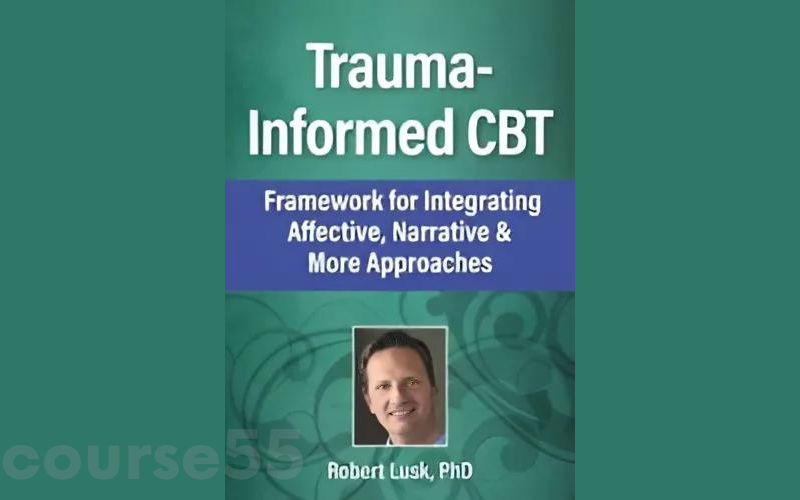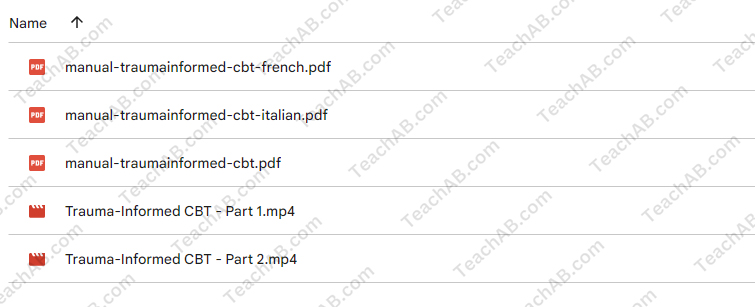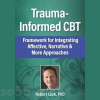Trauma-Informed CBT: A Framework for Integrating Affective, Narrative & More Approaches By Robert Lusk – PESI
$199.00 Original price was: $199.00.$46.00Current price is: $46.00.
Review of Trauma-Informed CBT (trauma-informed cognitive behavioral therapy): A framework for integrating affective, narrative & more approaches by Robert Lusk
Content Proof:
Trauma impacts children and adolescents profoundly, often leaving invisible scars that manifest as anxiety, depression, and behavioral issues. In response to these challenges, trauma-informed cognitive behavioral therapy (TF-CBT) emerges as an innovative and compassionate framework. This approach not only addresses the emotional aftermath of traumatic experiences but also embeds a structured methodology that helps young clients reclaim their narratives. Robert Lusk, a notable figure in this realm, integrates narrative techniques with the fundamentals of TF-CBT, offering practitioners new avenues to engage with young clients. Through his work, practitioners are equipped to foster resilience, emotional regulation, and healing in the lives of those deeply affected by trauma.
Understanding TF-CBT: Core Components and Structure
TF-CBT is structured around three critical phases: stabilization, trauma narration and processing, and integration and consolidation. Each phase represents a step towards recovery, much like a therapeutic ladder where each rung elevates the child closer to healing. This structured approach allows therapists to focus on essential components that address both the emotional and cognitive needs of their clients.
1. Stabilization Phase
This first phase serves as the foundation where children learn to manage overwhelming feelings associated with their trauma. The emphasis here is on creating a safe therapeutic environment. Techniques such as psychoeducation, relaxation, and affect regulation are introduced. These are akin to teaching a swimmer to float before they dive into deeper waters; children must first understand their emotions and develop coping mechanisms before tackling traumatic memories. For example, relaxation techniques may involve guided imagery or deep-breathing exercises that help children regain control over their physiological responses.
2. Trauma Narration and Processing Phase
In this phase, children engage in the delicate process of narrating their traumatic experiences. Here, elements such as cognitive coping and in vivo exposure play vital roles. They assist clients in reconstructing their narratives in a controlled manner. This phase can be likened to a sculptor chiseling away at a marble block to reveal a statue; through careful reflection and modeling of their memories, children can shape their understanding and emotional responses toward their trauma.
During this process, therapists encourage clients to articulate their experiences openly, which can lead to profound emotional release. For instance, a child might create a storybook depicting their trauma, facilitating not just catharsis but also cognitive reframing, which aids in transforming negative self-perceptions into more empowering narratives.
3. Integration and Consolidation Phase
The final phase of TF-CBT focuses on solidifying the gains made throughout therapy and preparing the child for future challenges. Enhancing safety and future development are pivotal here. By integrating lessons learned regarding emotional regulation and adaptive coping strategies, children emerge from therapy not just as survivors but as equipped individuals ready to face life’s complexities. This resounding message of hope is reinforced by the development of a conjoint parent-child session aimed at fostering understanding and support within family dynamics.
The Role of Language in TF-CBT
Language is a powerful tool, especially when working with children whose linguistic abilities and developmental stages vary significantly. In TF-CBT, effective communication is essential for articulating feelings and fostering understanding. This concept underscores the importance of not just what is said but how it’s said.
Adapting Language for Different Age Groups
Therapists must employ age-appropriate language that resonates with their young clients. For preschoolers, who often have limited verbal skills, the use of creative play, imagery, and art becomes crucial. For instance, a therapist might use puppets to facilitate dialogue, allowing children to express their feelings indirectly. Conversely, older children may require more sophisticated language to articulate their experiences and emotions clearly. This adaptive use of language is akin to tailoring a coat; it must fit snugly to be effective.
Enhancing Emotional Expression Through Language
Integrating emotional expression and cognitive understanding is critical in trauma recovery. By encouraging children to articulate their feelings associated with the trauma, clinicians can help demystify the emotions swirling within. This process not only aids in emotional regulation but also fosters a deeper comprehension of personal experiences, enabling clients to reframe their stories into a more resilient narrative. Research suggests that therapy incorporating strong narrative components can significantly reduce symptoms of anxiety and depression in traumatized children, showcasing the efficacy of this approach.
Expanding the Framework: Robert Lusk’s Contributions
Robert Lusk’s body of work in trauma-informed cognitive behavioral therapy (TI-CBT) enhances the already robust framework of TF-CBT. Lusk emphasizes the integration of narrative techniques, breathing new life into the treatment of trauma. His structured approach allows therapists to blend traditional cognitive behavioral strategies with narrative methods to promote deeper healing.
1. TI-CBT Training Programs
Lusk offers a wide array of training programs designed for mental health professionals seeking to enhance their understanding and application of TI-CBT. His courses cover essential elements such as:
- Narrative Techniques: The infusion of narrative psychology helps clients articulate their stories meaningfully.
- Integrating Mindfulness and Somatic Strategies: These techniques support emotional regulation and reinforce cognitive processing.
- Client Session Structuring: Participants learn how to create effective and engaging therapeutic sessions that resonate with clients’ experiences.
2. Workshops and Webinars
Through engaging workshops and webinars, Lusk expounds upon the transformative potential of narrative within cognitive behavioral frameworks. He provides valuable insights into how therapists can shift negative self-thoughts and harsh worldviews throughout the therapeutic process. These webinars illustrate practical applications of narrative techniques alongside case examples that underscore the effectiveness of this approach.
3. Target Audience
Lusk’s training is accessible to a diverse audience that includes:
- Counselors
- Psychologists
- Social workers
- Other mental health practitioners
This broad reach ensures that clinicians from various backgrounds can gain skills requisite for addressing trauma in children and adolescents effectively.
The Broader Context of Trauma-Informed Care
A holistic approach is fundamental in trauma-informed care, recognizing that each child’s experiences are shaped by a myriad of contextual factors. Understanding a client’s cultural background, family dynamics, and individual developmental trajectories enriches the therapeutic process and enhances engagement.
Recognizing Cultural Influences
Cultural considerations are important in tailoring TF-CBT to meet the unique needs of diverse populations. Adaptations in treatment strategies might be necessary based on cultural beliefs and values, impacting how trauma is perceived and processed. Acknowledging these nuances is like adjusting the sails on a boat; it ensures that the therapeutic journey remains true to the client’s unique experiences and perspectives.
Understanding Family Dynamics
Family plays a critical role in a child’s recovery journey. Engaging families through conjoint sessions not only amplifies safety and support but also influences a child’s recovery prospects positively. These sessions create a space where families can learn together, fostering understanding and shared resilience.
Conclusion
The integration of affective, narrative, and cognitive strategies within trauma-informed cognitive behavioral therapy represents a progressive approach to addressing children’s mental health needs. Robert Lusk’s contributions highlight the importance of narrative techniques and comprehensive training for practitioners to navigate the complexities of trauma. As the understanding of trauma evolves, so too does the capacity for healing in the children and adolescents affected by it. TF-CBT stands as a testament to the resilience of the human spirit a journey of recovery that transforms trauma into a narrative of strength and empowerment. Through informed practices, compassionate engagement, and the power of storytelling, a brighter future emerges for those who have faced the darkness of trauma.
Frequently Asked Questions:
Business Model Innovation: We use a group buying strategy that enables participants to share costs and access popular courses at lower prices. This approach helps individuals with limited financial resources, although it may raise concerns among content creators regarding distribution methods.
Legal Considerations: Our operations navigate complex legal issues. While we do not have explicit permission from course creators to resell their content, there are no specific resale restrictions mentioned at the time of purchase. This lack of clarity allows us to offer affordable educational resources.
Quality Control: We guarantee that all course materials provided are identical to those offered directly by the creators. However, please note that we are not official providers. As a result, our services do not include:
– Live coaching calls or sessions with the course author
– Access to exclusive author-controlled groups or portals
– Membership in private forums
– Direct email support from the author or their team
Our goal is to make education more accessible by offering these courses independently, without the additional premium services available through official channels. We appreciate your understanding of our unique approach.
Be the first to review “Trauma-Informed CBT: A Framework for Integrating Affective, Narrative & More Approaches By Robert Lusk – PESI” Cancel reply
You must be logged in to post a review.
Related products
Healthcare
Spinal Neigong – The Inner Workings of Stability and Fluidity 2022 – Bruce Frantzis – Energy Arts
Healthcare
Healthcare



















Reviews
There are no reviews yet.